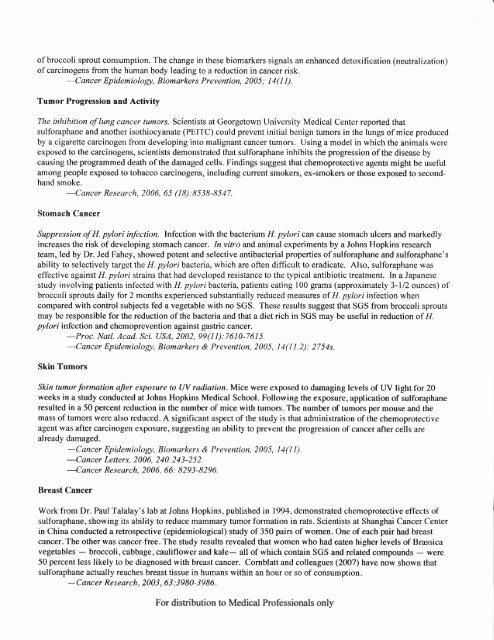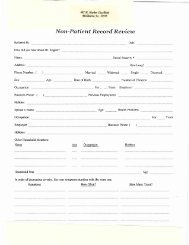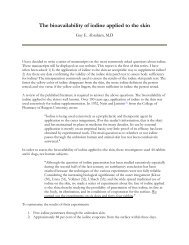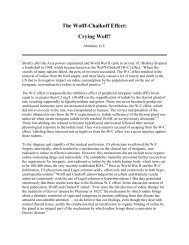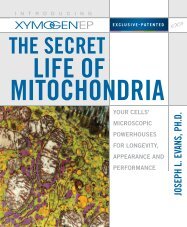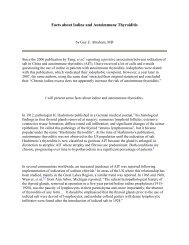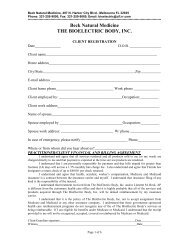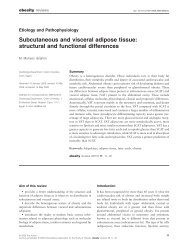Johns Hopkin's Brassica SGS I - Beck Natural Medicine University
Johns Hopkin's Brassica SGS I - Beck Natural Medicine University
Johns Hopkin's Brassica SGS I - Beck Natural Medicine University
You also want an ePaper? Increase the reach of your titles
YUMPU automatically turns print PDFs into web optimized ePapers that Google loves.
of broccoli sprout consumption. The change in these biomarkers signals an enhanced detoxification (neutralization)<br />
of carcinogens from the human body leading to a reduction in cancer risk.<br />
-Cancer Epidemiologt, Biomarkers Prevention, 2005 ; I a(l 1).<br />
Tumor Progression and Activity<br />
The inhibition of lung cancer tumors. Scientists at Georgetown <strong>University</strong> Medical Center reported that<br />
sulforaphane and another isothiocyanate (PEITC) could prevent initial benign tumors in the lungs of mice produced<br />
by a cigarette carcinogen from developing into malignant cancer tumors. Using a model in which the animals were<br />
exposed to the carcinogens, scientists demonstrated that sulforaphane inhibits the progression ofthe disease by<br />
causing the programmed death of the damaged cells. Findings suggest that chemoprotective agents might be useful<br />
among people exposed to tobacco carcinogens, including current smokers, ex-smokers or those exposed to secondhand<br />
smoke.<br />
-Cancer Research, 2006, 65 (18):8538-8547.<br />
Stomach Cancer<br />
Suppression of H. pylori infection. Infection with the bacterium H. pylori can cause stomach ulcers and markedly<br />
increases the risk of developing stomach cancer. In vitro and animal experiments by a <strong>Johns</strong> Hopkins research<br />
team, led by Dr. Jed Fahey, showed potent and selective antibacterial properties of sulforaphane and sulforaphane's<br />
ability to selectively target Ihe H. pylori bacteria, which are often difficult to eradicate. Also, sulforaphane was<br />
effective against H. pylori strains that had developed resistance to the typical antibiotic treatment. In a Japanese<br />
study involving patients infected with FL pylori bacteria, patients eating 100 grams (approximately 3-112 ounces) of<br />
broccoli sprouts daily for 2 months experienced substantially reduced measures of H. pylori infection when<br />
compared with control subjects fed a vegetable with no <strong>SGS</strong>. These results suggest that <strong>SGS</strong> from broccoli sprouts<br />
may be responsible for the reduction of the bacteria and that a diet rich in <strong>SGS</strong> may be useful in reduction of 1L<br />
pylori infection and chemoprevention against gastric cancer.<br />
Natl. Acad. Sci. USA, 2002, 99(11):7610-7615.<br />
-Proe<br />
Epidemiology, Biomarkers & Prevention, 2005, l4(11.2): 2754s.<br />
-Cancer<br />
Skin Tumors<br />
Skin tumor formation afier exposure to UV radiation. Mice were exposed to damaging levels of UV light for 20<br />
weeks in a study conducted at <strong>Johns</strong> Hopkins Medical School. Following the exposure, application of sulforaphane<br />
resulted in a 50 percent reduction in the number of mice with tumors. The number of tumors per mouse and the<br />
mass of tumors were also reduced. A significant aspect of the study is that administration of the chemoprotective<br />
agent was after carcinogen exposure, suggesting an ability to prevent the progression of cancer after cells are<br />
already damaged.<br />
Epidemiologt, Biomarkers<br />
-Cancer<br />
& Prevention, 2005, 14(1i').<br />
Letters. 2 006. 240 : 24 3-2 52.<br />
-Cancer<br />
Research. 2006. 66: 8293-8296.<br />
-lancer<br />
Breast Cancer<br />
Work from Dr. Paul Talalay's lab at <strong>Johns</strong> Hopkins, published in 1994, demonstrated chemoprotective effects of<br />
sulforaphane, showing its ability to reduce mammary tumor formation in rats. Scientists at Shanghai Cancer Center<br />
in China conducted a retrospective (epidemiological) study of 350 pairs of women. One of each pair had breast<br />
cancer. The other was cancer-free. The study results revealed that women who had eaten higher levels of <strong>Brassica</strong><br />
vegetables<br />
- broccoli, cabbage, cauliflower and kale- all of which contain <strong>SGS</strong> and related compounds - were<br />
50 percent less likely to be diagnosed with breast cancer. Cornblatt and colleagues (2007) have now shown that<br />
sulforaphane actually reaches breast tissue in humans within an hour or so of consumption.<br />
Cancer Re s earch. 2003. 63 : 3 980-3 986.<br />
-<br />
For distribution to Medical Professionals only


